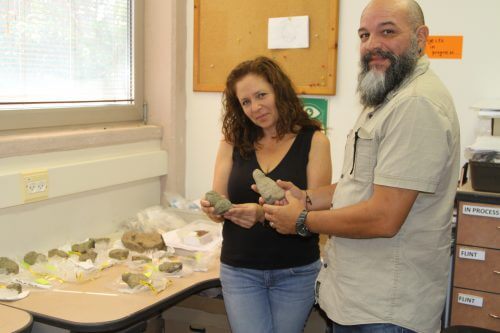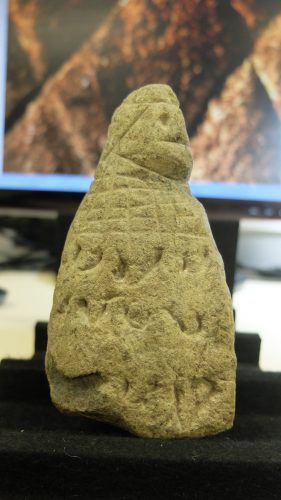* Dr. Iris Gruman Yaroslavsky from the University of Haifa has never experienced such an experience: a researcher from Puerto Rico came to her laboratory with mysterious figurines carved out of stone and asked for her help to check whether it was real or fake. "These are artefacts that have not been found so far in this region of America, which made many researchers think that they are fake, but the macroscopic tests we performed indicate without a shadow of a doubt that these are stones that were quarried several hundred years ago," she said*

The secret of mysterious archeological findings from Puerto Rico, which in the past were even claimed to have been created by the members of the lost ten tribes, has taken another step towards cracking thanks to in-depth tests carried out in the laboratory of Dr. Iris Gruman Yaroslavsky from the University of Haifa. Not only did the tests strengthen the theory that the artefacts are not modern forgeries, but they also revealed signs that some of the objects may have been covered in gold. "There is no doubt that this is one of the strangest and most fascinating stories that I had the chance to take part in. These are artefacts carved in stone that have not been found in this region of America so far, which has led many researchers to think that they are fake, but the macroscopic tests we performed indicate without a shadow of a doubt that these are stones that were carved several hundred years ago," said Dr. Gorman Yaroslavsky .
The story of the art objects, the "Library of Agüeybaná", seems to be taken from an Indiana Jones movie. During the 19th century, a Puerto Rican monk named José María Nazario presented a treasure trove of about 800 carved stone figurines, some clearly human and some appearing to be objects of art and worship, with many of them engraved with signs that cannot look like anything Except cuneiform. The problem: until then and since then, no similar figurines or other artefacts have been found in this region of the Americas and no evidence of any writing has been found in other pre-Columbian cultures of the region. The signs also did not resemble in any way the writing of the Aztecs or the Mayans. The story the monk told was no less miraculous: an old and dying woman, scion of a family native to the place, invited him to a cabin in the mountains and there on her deathbed she told him about the treasure that her family had been guarding for hundreds of years, the treasure of the ancient people of the place, and even gave him a detailed explanation of how to get there to the place where the treasure is buried. After following her explanations deep into the mountains, he came to a pit covered by a rolling stone - just as the woman said - and when he lifted the stone he discovered the hundreds of figurines. Given that he was a religious man, his explanation for the miraculous find was that these were artefacts created by members of the lost ten Hebrew tribes, who arrived in Puerto Rico on a journey through Siberia.

Different researchers throughout the periods put forward different opinions about the stones and engravings: some claimed that at least some of the figurines were authentic - and others were faked by the locals in the 19th century when they saw the great interest created by the real figurines - and some claimed that all the figurines were fake and were probably made by the monk Nazario or by others. There was also no agreement regarding the engravings of the script, when there were experts who claimed that it was a script that resembled a Sumerian script, others claimed that the script resembled a Phoenician script, and other suggestions.
In view of the fact that it is not possible to find a similar find and it was difficult to verify or refute the authenticity of the figurines, over the years the researchers lost interest in this unique find. Until 2001 when a research student named Reniel Rodríguez Ramos, now a professor at the University of Puerto Rico, saw the stones and was captivated by them. Prof. Rodríguez finished his PhD in pre-Columbian civilizations and returned to study the stones. "I decided to explore the stones from the beginning. To approach them like a 'smooth board' without any preconceived notions about their authenticity and let the findings speak for themselves," he said. According to him, even at first glance you could see that the stones were several hundred years old. A large part of them changed their color only on one side, which indicated that one side was buried in the ground and the other side was exposed to the air and the sun - and therefore changed its color. Those that could still be argued that the stones may be ancient - but the engraving and chipping was done only in the 19th century.
After a careful search, he arrived at Dr. Gruman Yaroslavsky's laboratory for researching signs of use at the University of Haifa. The uniqueness of the laboratory is that it specializes in microscopic tests that show how different objects were created, what tools were used, whether they are ancient techniques, ancient tools, etc. The macroscopic tests conducted by Dr. Gruman Yaroslavsky unequivocally testified that these are figurines carved in antiquity. "Under the eye of the microscope you can see the erosion of the stones and a layer of brown-gray patina that characterizes long-term processes of items buried or exposed to the ravages of nature. The items are made of a mineral that was originally greenish-black in color but the erosion covers the engravings on the entire surface of the item and there is no evidence of any modern manipulation that reveals the natural surface of the mineral. The processing marks on the items indicate that special tools were used for the chiseling work, and it seems that there was a unique style that was the same in all the items," she said. However, during the analysis, something was discovered that even Prof. Rodríguez did not expect - remains of gold, which apparently covered some of the figurines, which further strengthens the belief that they were ancient cult objects. Also, remnants of red paint were discovered that covered parts of the details of the eyes and mouth, which indicates a complex process of design and finishing. According to Dr. Groman Yaroslavsky, gold and red ocher minerals exist in Puerto Rico and there is extensive documentation on the use of these minerals in a ritual context. She even added that the context for ritual activity seemed clearer even when the details of the interior design of the items were examined. "It is clear that the items were hit with something hard because there is a deliberate mutilation of the nose and chin areas," she said.
In light of the new findings he received from the University of Haifa, Prof. Rodriguez is now continuing his journey to understand the artifacts, with his next address being a renowned expert on ancient writing in pre-Columbian America. The road to full decipherment is still far, but with each step it advances the conclusion sharpens: an ancient and unknown pre-Columbian culture waiting to be uncovered.

2 תגובות
You didn't understand, the origin of the figurines is in Puerto Rico. There was an argument about their age and the researcher from the University of Haifa helped resolve it. They arrived in Israel by flight together with the Puerto Rican researcher. Not found here.
This matches the findings from a DNA test for 6000-year-old skeletons from Peru which reveals that they originate from the Levant region, search on Google:
New DNA Results Released from the Paracas Elongated Skulls
The skeletons have a mutation of very elongated skulls and red hair, it seems that they were skilled sailors who somehow rolled into Peru and settled on an isolated beach in a desert area (Parax) perhaps because of the fear of the Indians (who seem to have slaughtered and exterminated them in the end).